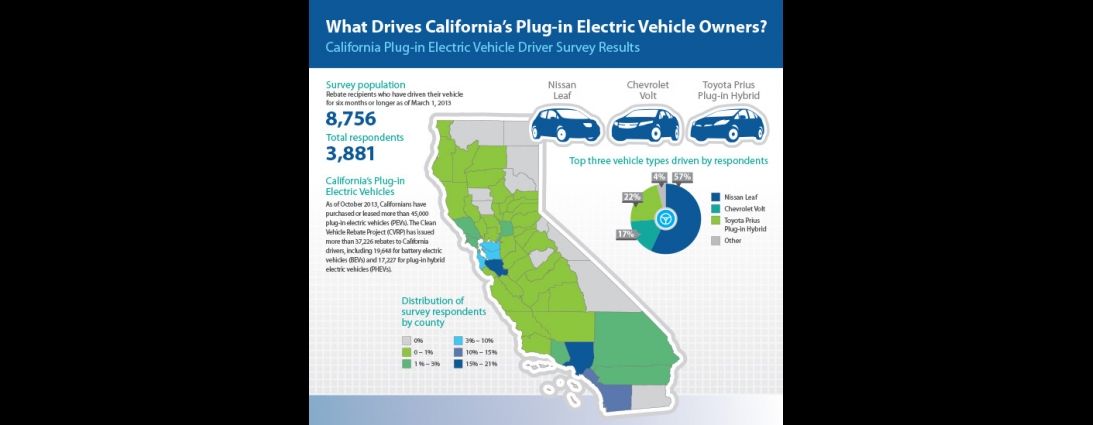

The latest survey of California’s plug-in electric vehicle (PEV) drivers shows differences in primary purchase motivations from owners of one model to the next. The survey also shows increased satisfaction with public charging options and wider availability of workplace charging than in previous surveys.
As administrators of the California Air Resources Board’s Clean Vehicle Rebate Project (CVRP), CCSE conducts ongoing PEV owner surveys.
With more than 3,500 responses in this round alone, the study is the largest and most comprehensive survey of PEV drivers in the nation, supplying details on demographics, purchasing motivations, charging behavior and access to public and residential charging. An infographic of the survey results is available here.
The current survey results cover owners who have owned their PEV for at least six months as of March 1, 2013. PEVs include battery electric vehicles (BEVs) that run exclusively on battery power and plug-in hybrid electric vehicles (PHEVs) that combine a gas-powered engine with an electric motor.
Participation in previous rounds of the CCSE survey consisted largely of all-electric Nissan Leaf drivers. The latest survey is the first time drivers of multiple vehicle types have participated. The majority of respondents own one of the following vehicles— 57% of participants own a Leaf (BEV), 17% own a Chevrolet Volt (PHEV) and 22% own a Toyota Prius Plug-in (PHEV).
As of January 15, 2014, more than 46,500 Californians have purchased or leased PEVs and applied for rebates from the CVRP. California is the nation’s largest PEV market with more than 63,000 vehicles, roughly 35 percent of the U.S. total, with sales adding in excess of 3,000 additional cars in the state each month.
“The plug-in electric vehicle market share has continued to accelerate,” said Colin Santulli, CCSE’s senior manager of transportation programs. “Continuing to explore and understand this market is more vital than ever.”
Highlights from the survey
- The primary motivations for vehicle purchase vary significantly between models – Leaf drivers indicated the environment as the primary motivator, Plug-in Prius owners stated HOV lane access and Volt drivers specified fuel savings.
- Respondents owning Chevy Volts are more than four times as likely to have a level 2 charging station installed at their home than Toyota Prius Plug-In respondents.
- Workplace charging availability is becoming more widespread, 46% of respondents reported access to workplace charging, an increase of 14% from March 2012.
- Of those with access to workplace charging, 74% have access to this charging at no cost to the driver, down from 89% in March 2012.
- Though low, driver satisfaction with public charging infrastructure continues to improve, rising from 17% in March 2012 to 29% in May 2013.
- HOV lane access was an extremely or a very important purchase motivation for 59% of respondents; 84% are displaying the HOV lane access sticker.
Future surveys and other resources
Previous survey reports and accompanying infographics are available online at CCSE’s website at www.energycenter.org/pevsurvey.
This is the third and final report produced from the CRVP PEV Driver Survey. Future survey results will be available via a regularly updated interactive online dashboard covering a variety of research areas. The dashboard, due to be launched in the spring, will provide researchers and other PEV stakeholders faster access to the most up-to-date PEV market data, according to Santulli.
CCSE also offers an online map depicting region-specific PEV adoption rates based on the number of rebates issued by ZIP code and the type of PEV purchased. The map is available at www.energycenter.org/CVRPRebateMap.
A leader in electric and alternative fuel transportation planning and programs in California, CCSE has issued more than $98.7 million in incentives and helped to educate hundreds of thousands of Californians on the availability and benefits of zero-emission vehicles since the rebate project’s inception in 2010.
